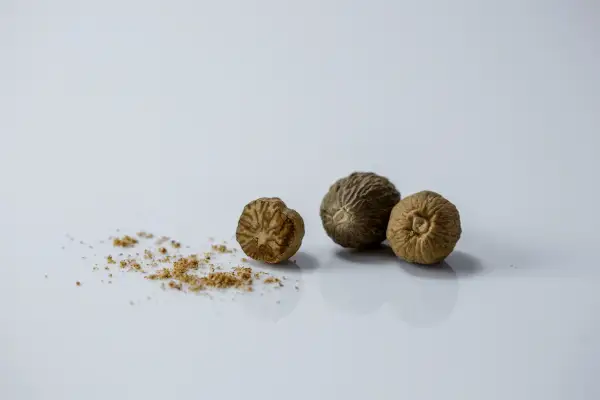Nutmeg
Herb/Spice
Age Suggestion
6 months
Iron-Rich
No
Common Allergen
No

When can babies have nutmeg?
Nutmeg may be introduced into meals in small amounts as soon as baby is ready to start solids, which is generally around 6 months of age. When adding the spice directly to baby’s food, keep the amount to a small pinch—excessive amounts of nutmeg can cause neurological, respiratory, and other symptoms. Nutmeg can also come in the form of nutmeg butters, oils, and teas, all of which should be avoided for baby to avoid excessive nutmeg ingestion.
Warning
Nutmeg contains a compound called myristicin, which can lead to neurological, hallucinogenic, respiratory, and other symptoms when consumed in excess, but accidental excess nutmeg intake is extremely rare when consuming it in regular cooking.
Where does nutmeg come from?
Nutmeg comes from the stone fruit of a tropical evergreen tree that originated in the Maluku islands of Southeast Asia. Most nutmeg still comes from the region, though nutmeg trees planted by colonizers in the tropics of the Americas and South Asia also produce fruits. To make nutmeg, the fruit’s pit is dried until the seed shrivels and pulls away from its shell. During this process, the bright red casing surrounding the pit is also dried to make the spice called mace. Both mace and nutmeg are used to season sweet and savory foods like bakso bakar meatballs, gulai curry, and jerk chicken.
Videos
Is nutmeg safe for babies?
Yes, nutmeg is generally recognized as safe by the U.S. Food & Drug Administration in amounts typically used in cooking. It’s important to note, however, that nutmeg contains a compound called myristicin, which can lead to neurological, hallucinogenic, respiratory, and other symptoms when consumed in excess, but accidental excess nutmeg intake is extremely rare when consuming it in regular cooking. In cooking, nutmeg is typically used in small amounts that are then spread over multiple portions of a dish, making it fine to serve, even for babies just starting solids. The more realistic risk for babies and toddlers comes from the possibility of accidental exposure, such as an unsupervised toddler getting hold of nutmeg from the spice cabinet. Out of an abundance of caution, keep nutmeg out of reach of children to ensure that a child does not accidentally ingest more than would be safe.
Nutmeg can also come in the form of nutmeg butters, oils, and teas, all of which should be avoided for baby to avoid excessive nutmeg ingestion.
Is nutmeg healthy for babies?
Yes, when used in amounts typical in cooking. Nutmeg offers small amounts of a variety of vitamins, minerals, and fiber to support baby’s overall health and development.
Nutmeg can also come in the form of nutmeg butter, oil, and tea, all of which should be avoided for baby to avoid excessive nutmeg ingestion.
★Tip: Nutmeg can be purchased as a powder or as an intact seed. For fresher flavor, choose whole seeds and grate only the amount needed for a recipe. The remaining seed may be stored in an airtight container to be used again later.
Is nutmeg a common choking hazard for babies?
No, finely ground nutmeg does not pose a high risk of choking. To minimize the risk, sprinkle thinly on or into foods and keep whole nutmeg away from babies and toddlers. As always, make sure you create a safe eating environment and stay within an arm’s reach of baby during meals. For more information on choking, visit our sections on gagging and choking and familiarize yourself with the list of common choking hazards.
Is nutmeg a common allergen?
No. Allergies to nutmeg are rare, but have been reported on occasion. If the child has other food allergies, read the label of any spice blend carefully – certain spice blends that feature nutmeg may contain common food allergens, such as nuts or sesame seed.
Even though nutmeg allergy is uncommon, spices can cause symptoms that are similar to allergic reactions. For example, inhaling a puff of powdered nutmeg can irritate the nasal passages and trigger sneezing and coughing due to an irritant response, rather than an allergic reaction. Additionally, nutmeg has been reported to cause contact rashes due to potentially skin-irritating components in the food, as well as contact allergy.
It is common for babies to develop a rash around their mouths after eating foods with spices such as nutmeg. A rash around the mouth after contact with spiced foods is typically just a skin irritation, and is rarely an actual allergic reaction. Spicy foods may also cause or worsen diaper rash. As nutmeg is generally used in very small quantities, the risk of a severe contact rash is low. If your baby has sensitive skin, talk to your baby’s doctor about applying a thin layer of barrier cream or ointment—such as pure petroleum jelly or a plant-based oil/wax balm—to baby’s face and diaper area before mealtime. This layer of protection will help prevent contact rashes by serving as a barrier between the skin and the potentially irritating components of food.
As you would when introducing any new food, start by offering a small quantity for the first few servings. If there is no adverse reaction, gradually increase the quantity over future meals.
Can nutmeg help babies poop?
No. Nutmeg is not generally considered a food that helps with pooping since it is consumed in small amounts in the diet. However, spices like nutmeg help play a role in supporting baby’s rapidly developing gut microbiome (the bacteria and microorganisms in baby’s intestines), which can help with healthy digestion overall. Remember that pooping patterns can vary significantly from baby to baby. If you have concerns about baby’s pooping and digestive function, check out our page on knowing when to worry about baby’s poop and, as always, talk to your pediatric healthcare provider.
How do you introduce nutmeg to babies with baby-led weaning?
Every baby develops on their own timeline, and the suggestions on how to cut or prepare particular foods are generalizations for a broad audience.
6 to 11 months old:
Sprinkle a small pinch of ground nutmeg on age-appropriate foods like strips of toast, warm cereals, and yogurt, or into the batter for baked goods like pancakes. Contrary to popular belief, babies don’t need their food to be bland when they are starting solids. Just make sure to keep the amounts small, especially when adding directly to a child’s food: nutmeg has a strong flavor, and excessive amounts can cause illness.
12 months old and up:
Cook with ground nutmeg in savory and sweet dishes, or experiment with spice blends that contain nutmeg. Try using it with other ingredients to create rich sauces, add to the batter for baked goods, and much more. Just make sure the amount used is small.
Get ideas to mix up your meal plans with our Recipe & Meal Kit.
Written by
Expert Tips Delivered to Your Inbox
Sign up for weekly tips, recipes and more!
The content offered on SolidStarts.com is for informational purposes only. Solidstarts is not engaged in rendering professional advice, whether medical or otherwise, to individual users or their children or families. No content on this site, regardless of date, should ever be used as a substitute for direct medical advice from your doctor or your medical or health professional, nutritionist, or expert in pediatric feeding and eating. By accessing the content on SolidStarts.com, you acknowledge and agree that you are accepting the responsibility for your child’s health and well-being. In return for providing you with an array of content “baby-led weaning” information, you waive any claims that you or your child may have as a result of utilizing the content on SolidStarts.com.







